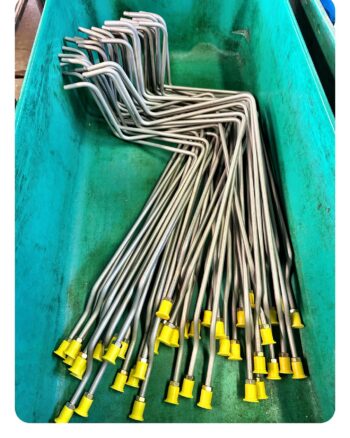When it comes to manufacturing with thin-walled tubes, precision isn’t just a nice-to-have; it’s a must. Whether you’re in aerospace, automotive, medical, or other high-demand industries, the slightest mistake in tube bending can compromise structural integrity, functionality, and safety.
This type of tube poses unique challenges due to its delicate nature, requiring specialized equipment, expertise, and meticulous planning to achieve the necessary accuracy.
Precision is Paramount in Thin-Walled Tube Bending
Thin-walled tubes are incredibly versatile, yet their delicate nature leaves little room for error during bending. Small deviations can cause cracking, wrinkling, or collapsing of the tube walls, rendering the component unusable. Precision isn’t just a preference; it’s a necessity.
Handling these materials requires advanced equipment and a skilled workforce. Here’s why precision matters:
- Structural Integrity: Misaligned or damaged bends compromise strength and functionality.
- Performance Efficiency: Thin walls mean tighter tolerances. A small mistake can lead to performance inefficiencies or part failure.
- Cost-Effectiveness: Wasted material or faulty parts increase costs. Precision bending minimizes these risks.
- Aesthetic and Design Standards: High-quality tube bending ensures a smooth, visually appealing finish.
Ultimately, precision ensures the final product functions exactly as intended, meeting stringent industry standards.
Why Accuracy Matters
Precision in tube bending is more than a matter of craftsmanship; it directly impacts performance and endurance in high-stress environments. For example:
- Medical Equipment: A bent tube with uneven curves can disrupt fluid dynamics in surgical instruments.
- Automotive: Misaligned bends can hinder the aerodynamic design of certain systems or structures.
- Aerospace: Even the smallest deviation can compromise an aircraft’s safety and efficiency.
The Role of Advanced Equipment
Modern tube bending services rely on specialized equipment designed to deal with thin-walled tubes. Some commonly utilized tools include:
- CNC Tube Benders: These computer-operated machines deliver precision and consistency, ensuring accuracy down to the millimeter.
- Mandrel Benders: Internal mandrels offer critical support during the bending process to maintain the tube’s shape, especially for tight radii.
- Rotary Draw Benders: These offer exact control for precision bends required in complex applications.
Key Design Considerations for Precision Tube Bending
Material Selection
Not all materials behave the same way under stress. Aluminum, steel alloys, and titanium are frequently used for thin-walled tubing due to their strength-to-weight ratio. However, each material requires its own bending techniques to prevent failure. Collaborating with engineers and tube bending providers early in the design phase can help mitigate issues down the line.
Wall Thickness and Bend Radius
The ratio of the bend radius to the diameter of the tube is one of the most critical metrics. Going below certain thresholds significantly increases the risk of defects such as cracking or wrinkling.
For example, a common guideline for thin-walled tubing is to keep the centerline radius at least 1.5 times the tube’s outer diameter. This ensures the structural integrity of the bend.
Surface Finish
Thin-walled tubes are frequently used in visible product areas or applications requiring a smooth interior surface for fluid flow. Minimizing surface imperfections during the bending process is essential for functionality and aesthetics. Advanced robotic bending systems can help with this, reducing human error.
Quality Testing
Consistency is critical, especially when manufacturing at scale. Services often incorporate nondestructive testing methods such as ultrasonic inspection or pressure testing to ensure the tubes meet performance criteria.
Why Choose Professionals for Thin-Walled Tubes
Collaborating with a specialized provider ensures access not only to advanced equipment but also to a team of experts who understand the unique challenges of thin-walled materials. Professional services typically include:
- Design Consulting: Work with engineers to optimize tube specifications for your application.
- Prototype Development: Test small batches before proceeding to large-scale manufacturing.
- Custom Solutions: Get tailored bends for one-of-a-kind projects or complex assemblies.
Additionally, top-tier providers often focus on sustainability by reducing material waste during the bending process, keeping costs and environmental impact low.
Why Partner with ACME for Precision Bending?
At ACME Tube Bending Co., we specialize in precision engineering for thin-walled tubes. Leveraging cutting-edge technology and a skilled team of experts, we deliver bending services tailored to your specific requirements. Here’s why we’re the right choice for your project:
- State-of-the-Art Equipment
We uses the latest in CNC technology as well as advanced bending techniques like mandrel bending and hydroforming to achieve unparalleled precision.
- Experienced Team
Our technicians bring decades of experience working with diverse industries and materials, ensuring your tubes are bent to perfection.
- Custom Solutions
No project is too complex. We work closely with clients to develop custom bending solutions that fulfill functional and aesthetic needs.
- Material Expertise
We handle a variety of materials, including stainless steel, aluminum, titanium, and specialty alloys that comply with industry standards.
- Quick Turnaround
Time is critical in many industries. At ACME Tube Bending, we pride ourselves on offering fast, reliable service without compromising quality.
- Quality Assurance
Every tube that leaves our facility undergoes rigorous testing and inspection, ensuring it meets your specifications and performs to the highest standards.
Whether you’re in aerospace, automotive, or healthcare, ACME has the expertise to bring your ideas to life with unmatched precision.